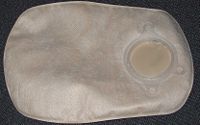Ostomy pouching system
Overview
An Ostomy Pouching System (also colloquially, and incorrectly called a Colostomy Bag) is a medical prosthetic that provides a means for the collection of waste from a diverted biological system (Colon, ileum, urinary); pouching systems are most commonly associated with colostomies, ileostomies, and urostomies.
Pouching systems usually consist of a mounting plate, commonly called a wafer and a collection pouch which is mechanically attached in a method that creates an airtight seal. Ostomy Pouching Systems are used to collect waste that is output from a stoma, the pouching system is attached to allow the stoma to drain into a sealed collection pouch, while also protecting the surrounding skin from contamination. Pouching systems come in one, and two piece designs; two piece designs allow the changing and use of multiple pouches while retaining the wafer for several days. The selection of systems varies greatly between individuals, and is often based on personal preference and lifestyle.
Ostomy pouching systems are air, and water tight and allow the wearer to lead an active normal lifestyle that can include all forms of sports and recreation.
Ostomy pouching systems are also sometimes referred to as an appliance, where the term appliance refers to a prosthesis, as a mechanical replacement for a biological function.
Wafers

Most wafers are manufactured using pectin or similar organic material, and are available in a wide variety of sizes to accommodate a person's particular anatomy. The internal opening must be the correct size to accommodate the individual's stoma while protecting the skin from contact with waste. The methods for sizing this opening varies depending on the type of wafer, some pre-cut sizes are available, however most users need to customize openings using scissors. Manufacturers have recently introduced moldable wafers than can be shaped by hand without the need for scissors.
Wafers are usually attached to the skin via a "peel and stick" adhesive backing, this skin-friendly adhesive is very strong and durable, and provides a water tight seal between the skin and the wafer. A wafer typically lasts between 4 to 10 days before it needs to be replaced, this is highly dependent on the individual's lifestyle, ostomy type, and anatomy.
Pouches

The method of attachment to the wafer varies between manufactures, and includes, permanent (one-piece), press-on ("Tupperware" type), turning locking rings, and the recently introduced "sticky" adhesive mounts. The two-piece arrangement allows pouches to be swapped without removing the wafer; for example, some people prefer to temporarily switch to a "mini-pouch" for swimming or other activities.
Pouches can be broken down into two basic types, open-end, (drainable), and closed-end (disposable). Open-end pouches have a resealable end that can be opened to drain the contents of the pouch into a toilet, the end is traditionally sealed with a plastic clip, however many manufacturers now offer a velcro-type closure at the end which eliminates the need for the clip. Closed-end pouches must be removed and replaced with a new pouch. The use of open-end vs. closed-end pouches is dependant on the frequency in which an individual needs to empty the contents, as well as economics.
Gas is created during digestion, and an airtight pouch will collect this and inflate, to prevent this
some pouch styles are available with special charcoal filtered vents that will allow the gas to escape.